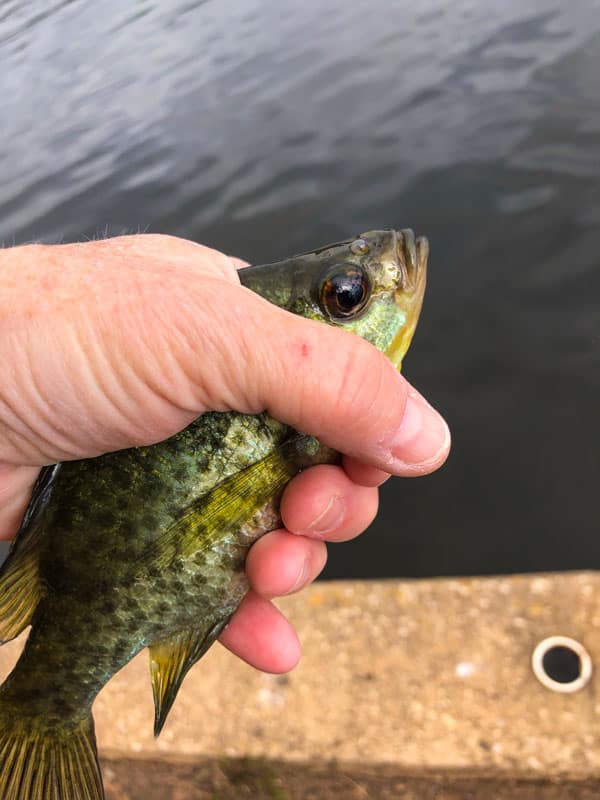Spotted Bass
Micropterus punctulatus
Spotted bass tend to congregate in schools unlike other types of bass fish.
Advertisement
Spotted Bass Scientific Classification
- Kingdom
- Animalia
- Phylum
- Chordata
- Class
- Actinopterygii
- Order
- Perciformes
- Family
- Centrarchidae
- Genus
- Micropterus
- Scientific Name
- Micropterus punctulatus
Read our Complete Guide to Classification of Animals.
Spotted Bass Conservation Status
Spotted Bass Facts
- Prey
- small crustaceans, insects, zooplankton, crayfish, smaller fish, larger crustaceans, frogs, worms, aquatic arthropods
- Main Prey
- crayfish, crustaceans, insects
- Name Of Young
- fry
- Group Behavior
- Social
- School
- Fun Fact
- Spotted bass tend to congregate in schools unlike other types of bass fish.
- Other Name(s)
- Kentucky Bass, spotted black bass
- Temperament
- aggressive
- Litter Size
- 1,150 - 47,000 eggs
- Lifestyle
- Sedentary
- Favorite Food
- crayfish
- Type
- bass
- Origin
- North America
Spotted Bass Physical Characteristics
- Color
- Black
- Green
- Olive
- Multi-colored
- Golden
- Light-Brown
- Skin Type
- Scales
- Venomous
- No
- Aggression
- High
View all of the Spotted Bass images!
Spotted Bass Summary
The spotted bass is a black bass endemic to North America, particularly the eastern part of the United States. These beautifully spotted fish are incredibly popular, not only for recreational sport but also as part of the local cuisine. They are often mistaken for their largemouth and smallmouth bass counterparts because of the beauty of their skin patterns. Due to their popularity as game fish, they have also been introduced to other countries.
Spotted Bass Facts
- Spotted bass are usually caught by accident because most fishermen target largemouth or smallmouth bass instead.
- Spotted bass like warm, moving waters, such as streams, rivers, and reservoirs. They can never be found in brackish water and seldom in natural lakes.
- Spotted bass are very popular in Kentucky. They are not only nicknamed the Kentucky bass, but also are Kentucky’s official state game fish.
- Spotted bass are very popular because of their aggressiveness when being caught. This has made them a go-to recreational fish in other countries, especially in Europe.
- Spotted bass are often confused for smallmouth and largemouth bass.
- Unlike other species of bass, spotted bass form large schools of fish and are more social. They are also sluggish and sedentary.
Spotted Bass Classification and Scientific Name
The spotted bass is a North American fish known in the science world as Micropterus punctulatus. Its generic name Micropterus means “small fin” while its specific name punctulatus means “spotted.” Its characteristic feature is its spotted skin, hence its name. This fish is usually referred to as “spotty” or “spots” by locals. It is also sometimes known as the Kentucky bass or the spotted black bass.
Spotted bass belongs to the family Centrarchidae, also called sunfishes, and order Perciformes.
Three subspecies of spotted bass have been recognized throughout the United States, such as Alabama spotted bass, northern spotted bass, and Wichita spotted bass.
Spotted Bass Appearance

Small spotted bass or “Kentucky bass” are popular game fish.
©iStock.com/Campwillowlake
Spotted bass are medium-sized fish. They have laterally compressed bodies and can be identified by their pale green to light golden-brown markings which cover their backs. They also have black spots, mottled pale sides and underbellies, and dark streaks of scales running along their sides. Spotted bass also have deep red eyes.
Spotted bass grow very slowly and don’t get extremely large like other bass species. They usually grow to be about 25 inches in length and less than 11 pounds in weight. The largest spotted bass ever recorded was 10.27 pounds and was caught in California.
Spotted bass are often mistaken for largemouth bass due to their similarities in appearance. They share similar mottled markings and colors with the largemouth bass. However, they can be differentiated by the size of their mouths. Spotted bass have significantly smaller mouths than largemouth bass. Also, the dark streaks of scales that run along the sides of the spotted bass are less uniform than those of largemouth bass. The cheek scales on the spotted bass are much smaller than the scales on the rest of its body, whereas the scales on a largemouth bass are all uniform in size.
Another fish the spotted bass is sometimes mistaken for is the smallmouth bass. One way to tell these two species apart is that the smallmouth bass has vertical stripes that the spotted bass doesn’t.
Spotted Bass Distribution, Population, and Habitat
Spotted bass are freshwater fish and prefer to inhabit moving water, such as rivers, reservoirs, and streams. They like water sources with gravelly and rocky beds. They live in warm waters that have enough aquatic vegetation and debris. You will hardly ever find these spotted beauties in a lake and never in brackish water. They like to inhabit areas with enough aquatic vegetation to enable them to hide from predators. They are also non-migrating fish.
Spotted bass are prolific and have spread throughout the United States despite originating in the eastern part of the country. They have a wide range and are endemic to the Mississippi River basin. They can be found from Texas to Florida, as well as in North Carolina, Georgia, Kentucky, and Virginia where they have been introduced. They are predominantly found around the Choctawhatchee River, as well as other moving water sources in Florida.
This fish was also introduced to southern Africa where it was considered an invasive species. After successful efforts, it was duly exterminated in 2014.
Spotted Bass Evolution and History
The spotted bass is a part of the freshwater ray-finned fish family, Centrarchidae, whose earliest fossils date back to the late Eocene (38 million to 33.9 million years ago) and early Oligocene (33.9 million to 23 million years ago) periods. These fossils belong to now-extinct genera of centrarchid fish, Plioplarchus and Boreocentrarchus, and were found in Montana and South Dakota in Miocene deposits that date back 23.03 to 5.333 million years ago. These early fossils, unlike the spotted bass, had more than three anal fin spines.
Members of the sunfish family typically share characteristic features such as having laterally compressed bodies, thoracic pelvic fins, three to eight anal fins, two dorsal fins, and six to 13 dorsal spines. Species in the genera Micropterus as well as Lepomis all have three anal fins. This unique physical feature is used to identify them and distinguish them from other members of the family.
Centrarchidae fish prefer warm water, therefore their native range is usually cut off by colder water and temperatures around southern Canada.
Centrarchidae contains eight genera and 38 species with only 34 of these species living today.
Spotted Bass Predators and Prey
Spotted bass are not large fish, so they typically have a lot of predators including snakes, alligators, and turtles. Humans can also be considered one of their predators.
Spotted bass do not face any immediate threats. However, climate change is a potential problem. These fish are predators and like to live in warm waters. Their range is bounded by cold northern temperatures. With waters becoming warmer, their range could possibly expand northward and put other aquatic species at risk of their invasion. Spotted bass have already become invasive species in the countries where they were introduced, such as southern Africa, Mexico, Italy, and Japan. Their presence in these locations has severely affected the native fish populations.
The spotted bass’s carnivorous diet depends on its lifecycle stage. As juvenile fish, they consume small crustaceans, insects, and zooplankton. When they mature into adults, their diet consists primarily of crayfish, smaller fish, larger crustaceans, frogs, worms, and aquatic arthropods.
Spotted bass are known to have a less voracious appetite than largemouth bass. Their hunting method involves opening their mouth in the presence of their prey and allowing the force of the pressure to sweep the prey into it.
Spotted Bass Reproduction and Lifespan
Spotted bass usually reach sexual maturity at the age of one, but oftentimes, they do not engage in reproduction until much later when they are around four years old.
The breeding season for the spotted bass typically takes place in the spring around April or May or when the temperature hits 63 degrees Fahrenheit. This can occur much earlier in the year provided the temperature is adequate.
The female spotted bass is enticed by the male to lay her eggs in a bed of gravel cleared by him, after which she is chased away. Female spotted bass can lay anything from 1,150 eggs to about 47,000 eggs. The male spotted bass then looks after the eggs, guarding them even after they hatch into fry, and a few weeks afterward.
Spotted bass have an average lifespan of six years old.
Spotted Bass Fishing and Cooking
Spotted bass are recreational and commercial fish. This means that they are successful sport fish, and are also caught to be eaten. They are frequently caught by accident by fishermen looking to catch largemouth or smallmouth bass instead.
If you are fishing for spotted bass, you would do well to have a powerful grip! Spotted bass are very aggressive fish when fighting to avoid being caught. When they are on the hook, they tend to swim downwards into the water rather than jump around. They are notorious for their fighting skills and resistance to being captured. This trait makes them interesting sport fish because they add to the challenge and give you a run for your money.
In order to increase your chances of catching a spotty, you should move to rocky banks and bluff ends. Spotted bass like to inhabit these types of places. The best times for fishing for spotted bass are in the early summer with prop baits or walking plugs, or in the late summer with worm bait.
Spotted bass meat is firm, white, and doesn’t have an extremely fishy taste. It is usually prepared pan-fried or pan-seared.
Spotted Bass Population
The conservation status of the spotted bass is listed as Least Concern on the IUCN Red List of Threatened Species. Its population is considered to be stable.
Related Animals
View all 293 animals that start with SSpotted Bass FAQs (Frequently Asked Questions)
Where are spotted bass found?
Spotted bass are freshwater fish and prefer to inhabit moving water such as rivers, reservoirs, and streams. They like water sources with gravelly and rocky beds. They live in warm waters that have enough aquatic vegetation and debris. You will hardly find these spotted beauties in a lake and never in brackish water.
What do spotted bass eat?
As juvenile fish, they consume small crustaceans, insects and zooplankton. When they mature into adults, their diet consists primarily of crayfish, smaller fish, larger crustaceans, frogs, worms, and aquatic arthropods.
Are spotted bass dangerous?
No, spotted bass are not harmful or dangerous to humans.
How long do spotted bass live?
Spotted bass have an average lifespan of six years.
What eats spotted bass?
Predators of the spotted bass include snakes, alligators, turtles, and humans.
What Kingdom do spotted bass belong to?
Spotted bass belong to the kingdom, Animalia.
What phylum do spotted bass belong to?
Spotted bass belong to the phylum, Chordata.
What class do spotted bass belong to?
Spotted bass belong to the class Actinopterygii.
What order do spotted bass belong to?
Spotted bass belong to the order, Perciformes.
What family do spotted bass belong to?
Spotted bass belong to the family, Centrarchidae.
What genus do spotted bass belong to?
Spotted bass belong to the genus Micropterus.
Thank you for reading! Have some feedback for us? Contact the AZ Animals editorial team.
Sources
- Wikipedia, Available here: https://en.wikipedia.org/wiki/Centrarchidae
- Wikipedia, Available here: https://en.wikipedia.org/wiki/Spotted_bass
- Encyclopedia of Arkansas, Available here: https://encyclopediaofarkansas.net/entries/centrarchid-fishes-14620/
- Froese, R. and D. Pauly. Editors, Available here: https://www.fishbase.se/summary/SpeciesSummary.php?ID=3384&AT=spotted+bass
- Texas Parks and Wildlife, Available here: https://tpwd.texas.gov/huntwild/wild/species/spb/

















